The Strategy and Science Behind Fish Stocking
Why fisheries experts stock certain species and sizes of fish in public water.

Stocking Trout
By Chris Penne, Utah DWR
from The Fishing Wire
“Why did you stock that species of fish in that water?” is one of the most common questions I get as a fisheries professional. That question is usually followed by “And, why did you stock the fish at that size?”
While the answer to each of these questions can be tied to specific situations, there are some general reasons why biologists choose to stock certain species and sizes of fish.
Providing fish and fun
Rainbow trout are a favorite catch for many anglers. We stock them in Utah’s community ponds in the spring and fall.
The most common reason to stock a fish in a river, lake or reservoir is to provide anglers with a recreational fishing opportunity.
Stocking rainbow trout in waters across Utah is a good example of recreational fish stocking. Rainbow trout are stocked solely to provide a great fishing experience for anglers.
Rainbow trout are very adaptable. They can be stocked everywhere from high-mountain lakes and streams to valley reservoirs — and even into the fisheries in our towns and cities. Other fish stocked for recreational reasons include brook trout, Arctic grayling, walleye and channel catfish.
Munching other fish
Our biologists are always happy to find chunky wipers during survey work — it means they’ve been eating the prey fish we’re trying to control.
In addition to providing a recreational opportunity, some fish are stocked for more scientific reasons — to serve as management tools. This means the stocked fish have a job to do. Often, that job is to consume (and thereby manage) overabundant forage fish, such as Utah chub or golden shiner.
Bear Lake cutthroat trout are a great example of a predator fish. We’ve stocked them in Strawberry, Scofield and Lost Creek reservoirs to feast on populations of Utah chub, a fish species that would get out of control without a predator to keep them in check.
Wipers — a hybrid cross between a striped bass and a white bass — are another predator we often use to control prey fish. Wipers prevent the overpopulation of prey species in Minersville, Newcastle and Scofield reservoirs.
In each case, these fish have a job to do first, but there’s a major upside to having them in these waters: they reach large sizes, providing anglers with a chance to catch a trophy fish.
Helping fish in need
There are other species of fish in Utah, particularly fish that are native to the state (i.e., in Utah when European settlers arrived), which need stocking to boost or maintain their populations until conditions improve.
In most cases, populations of these fish have decreased as a result of changes humans have made to the fish’s environment. Stocking them helps maintain or enhance populations while biologists work with partners to find and address the factors leading to the population decline.
This can be a slow process, but there are recent indications it’s working. For example, in recent years, the U.S. Fish and Wildlife Service has recommended that two fish — June sucker in Utah Lake and razorback sucker in the Colorado River — be downlisted from endangered to threatened on the federal Endangered Species list.
This move to downlist is only possible because populations of both species are improving. More work still needs to be done, but raising and stocking these fish is one of the key factors in the progress they’re making toward recovery.
Stocking fish at the right size
The fish that fisheries managers stock typically fall into one of three categories: fry, fingerlings or catchables.
Supplemental stocking has helped Utah’s razorback sucker population.
Fry are newly hatched fish that are just a few days old. Fingerlings are months older than fry, and — just like the name implies — are about the size of your finger, typically 3 to 6 inches long.
Catchables are even bigger. They get their name because they’ve already reached a size anglers want to catch.
Choosing which size to stock often comes down to giving anglers the most bang for their buck.
It takes personnel time and money to raise fish. In fact, because fish put on more weight for every inch they grow, every additional inch a fish grows makes it more expensive to raise.
Stocking fish at the smallest size necessary to achieve management goals saves a lot of money. With that in mind, fisheries managers frequently conduct comparisons of different sizes of fish to see which size provides anglers with the greatest return.
These tiger muskie fingerlings were stocked in Scofield Reservoir in 2017. Today, any surviving adult fish could be more than 3 feet long!
Being cost conscious allows us to stretch our funding farther and maximize the number and variety of fish we can stock for anglers.
Using research to improve efficiency
Most of the rainbow trout stocked in Utah enter the water as either large fingerlings or catchables. If we stocked rainbows at a smaller size, we could put even more into Utah’s waters, but the vast majority of these smaller rainbows wouldn’t survive.
We’ve learned through studies that for every dollar spent to raise them in a hatchery, anglers catch larger rainbow trout, at a higher rate, than they would if we stocked the fish at a smaller size. Therefore, it’s more cost effective to raise rainbow trout to a larger size before stocking them.
In contrast, other species — such as kokanee salmon, splake, tiger trout, wiper and tiger muskie — perform well when stocked as small fingerlings. Stocking them at a smaller size saves money that would otherwise be spent feeding and maintaining hatchery space for the fish as they continued growing.
Some fish, such as walleye, are stocked as fry. We stock these fish by the thousands — and even the millions. Despite being about the length of your fingernail and the width of a pinhead, walleye stocked as fry are a major contributor to some of Utah’s fisheries. Willard Bay Reservoir is a good example.
A study conducted at Willard Bay found stocking only 500,000 walleye fry each year created measurable increases in the already existing walleye population in the reservoir. In fact, during two years of the three-year study, walleye stocked in the reservoir as fry made up a larger portion of each new year class of fish than those produced by natural reproduction.
Stocking walleye fry may not be successful in every water, but you can bet fisheries managers will try stocking fry first before considering stocking larger walleye, simply because anglers are receiving more for their money by stocking smaller fish.
Understanding the strategy
So, there you have it. The next time you’re looking at fish stocking reports or reading a news story about a fish that’s been stocked somewhere in Utah — or reeling in a stocked fish — you’ll have a better idea why that fish was stocked in a particular location, at a particular size.
Chris Penne
Chris Penne is the regional aquatic manager in the DWR’s Ogden office. As a self-described fish-head, he loves managing fish on the job and then catching them in his spare time.





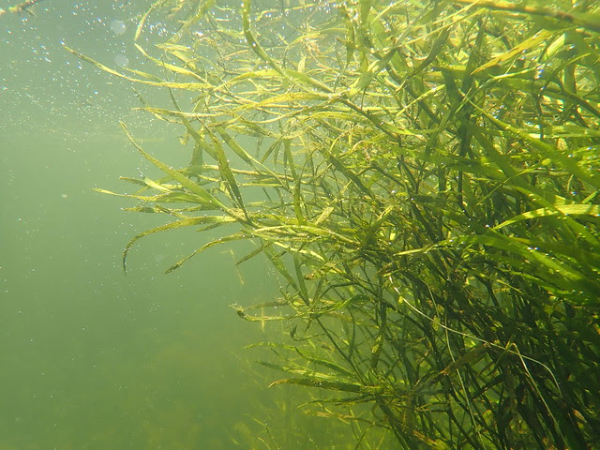 Submerged aquatic vegetation (SAV) is increasingly recognized as vital to aquatic ecosystems. Its importance is extolled during retellings of extreme weather events, e.g. how the widespread destruction of SAV following Tropical Storm Agnes in 1972 affected the Chesapeake Bay.
Submerged aquatic vegetation (SAV) is increasingly recognized as vital to aquatic ecosystems. Its importance is extolled during retellings of extreme weather events, e.g. how the widespread destruction of SAV following Tropical Storm Agnes in 1972 affected the Chesapeake Bay. 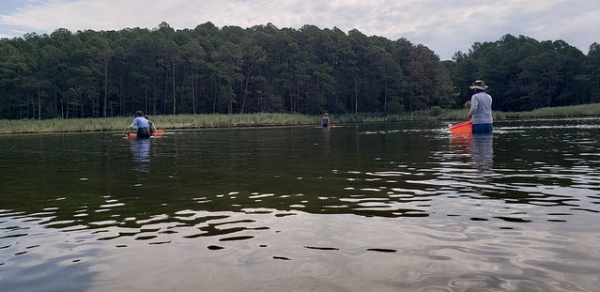 Biologists and ShoreRivers volunteers collect widgeon grass seeds near the mouth of Eastern Bay.
Biologists and ShoreRivers volunteers collect widgeon grass seeds near the mouth of Eastern Bay.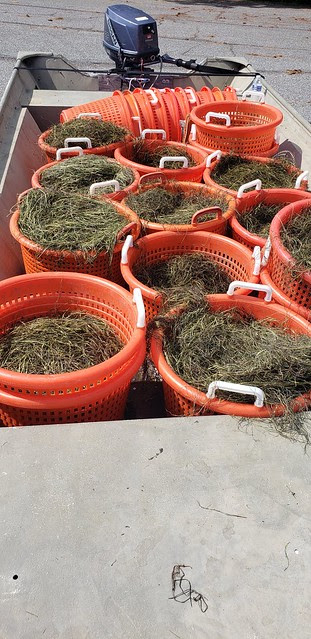
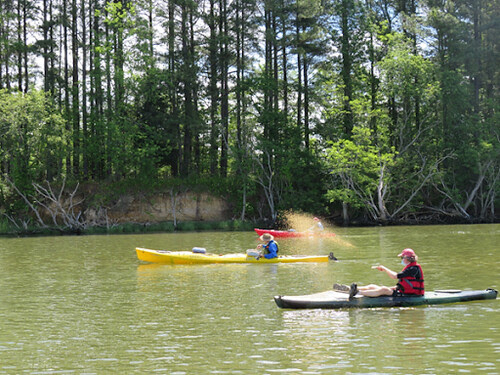

 DWR biologists electrofishing while sampling fish populations on a water body. Photos by Meghan Marchetti/DWR
DWR biologists electrofishing while sampling fish populations on a water body. Photos by Meghan Marchetti/DWR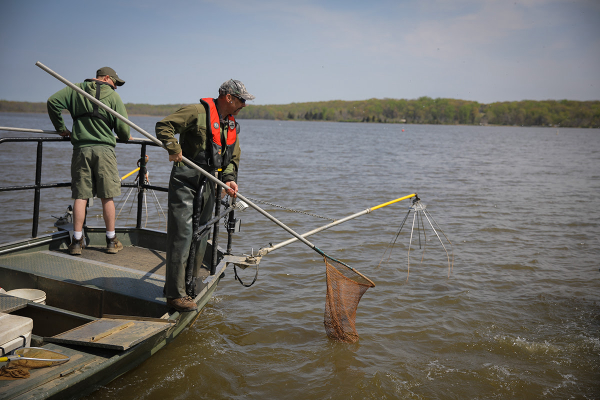 Electrofishing in action.As Virginia’s state fish and wildlife agency, DWR is responsible for the management of our fish and wildlife resources for the benefit of the public. Our agency staff work hard to conserve and protect our freshwater fisheries across the Commonwealth. The best way to monitor the health of fish populations is to catch a number of fish from one area at one time. While our aquatics biologists are all excellent anglers, there is a more efficient, safe, and effective way to catch the fish!
Electrofishing in action.As Virginia’s state fish and wildlife agency, DWR is responsible for the management of our fish and wildlife resources for the benefit of the public. Our agency staff work hard to conserve and protect our freshwater fisheries across the Commonwealth. The best way to monitor the health of fish populations is to catch a number of fish from one area at one time. While our aquatics biologists are all excellent anglers, there is a more efficient, safe, and effective way to catch the fish!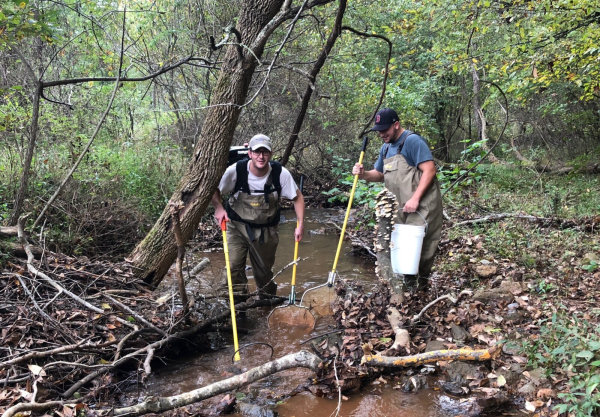 Electrofishing a stream with backpack equipment.
Electrofishing a stream with backpack equipment.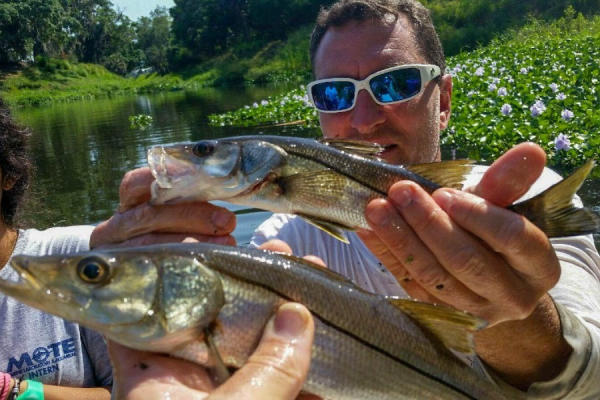 Mote’s Dr. Jim Locascio holds a juvenile snook from a Sarasota County canal. Credit: Dr. Nate Brennan/Mote Marine Laboratory
Mote’s Dr. Jim Locascio holds a juvenile snook from a Sarasota County canal. Credit: Dr. Nate Brennan/Mote Marine Laboratory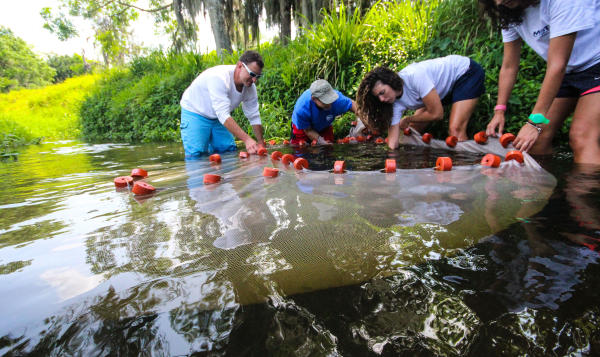 From left: Mote scientists Dr. Jim Locascio, Dr. Nate Brennan, and Greer Babbe use a seine net to survey for fish in Sarasota County’s stormwater canal system. Credit Conor Goulding/Mote Marine Laboratory.
From left: Mote scientists Dr. Jim Locascio, Dr. Nate Brennan, and Greer Babbe use a seine net to survey for fish in Sarasota County’s stormwater canal system. Credit Conor Goulding/Mote Marine Laboratory.